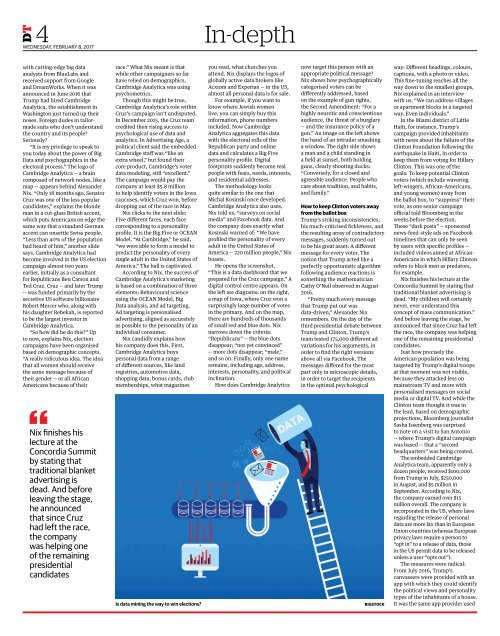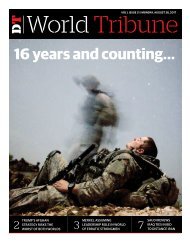Create successful ePaper yourself
Turn your PDF publications into a flip-book with our unique Google optimized e-Paper software.
4<br />
wednesday, february 8, <strong>2017</strong><br />
DT<br />
<strong>In</strong>-depth<br />
with cutting-edge big data<br />
analysts from BlueLabs and<br />
received support from Google<br />
and DreamWorks. When it was<br />
announced in June 2016 that<br />
Trump had hired Cambridge<br />
Analytica, the establishment in<br />
Washington just turned up their<br />
noses. Foreign dudes in tailormade<br />
suits who don’t understand<br />
the country and its people?<br />
Seriously?<br />
“It is my privilege to speak to<br />
you today about the power of Big<br />
Data and psychographics in the<br />
electoral process.” The logo of<br />
Cambridge Analytica -- a brain<br />
composed of network nodes, like a<br />
map -- appears behind Alexander<br />
Nix. “Only 18 months ago, Senator<br />
Cruz was one of the less popular<br />
candidates,” explains the blonde<br />
man in a cut-glass British accent,<br />
which puts Americans on edge the<br />
same way that a standard German<br />
accent can unsettle Swiss people.<br />
“Less than 40% of the population<br />
had heard of him,” another slide<br />
says. Cambridge Analytica had<br />
become involved in the US election<br />
campaign almost two years<br />
earlier, initially as a consultant<br />
for Republicans Ben Carson and<br />
Ted Cruz. Cruz -- and later Trump<br />
-- was funded primarily by the<br />
secretive US software billionaire<br />
Robert Mercer who, along with<br />
his daughter Rebekah, is reported<br />
to be the largest investor in<br />
Cambridge Analytica.<br />
“So how did he do this?” Up<br />
to now, explains Nix, election<br />
campaigns have been organised<br />
based on demographic concepts.<br />
“A really ridiculous idea. The idea<br />
that all women should receive<br />
the same message because of<br />
their gender -- or all African<br />
Americans because of their<br />
Nix finishes his<br />
lecture at the<br />
Concordia Summit<br />
by stating that<br />
traditional blanket<br />
advertising is<br />
dead. And before<br />
leaving the stage,<br />
he announced<br />
that since Cruz<br />
had left the race,<br />
the company<br />
was helping one<br />
of the remaining<br />
presidential<br />
candidates<br />
race.” What Nix meant is that<br />
while other campaigners so far<br />
have relied on demographics,<br />
Cambridge Analytica was using<br />
psychometrics.<br />
Though this might be true,<br />
Cambridge Analytica’s role within<br />
Cruz’s campaign isn’t undisputed.<br />
<strong>In</strong> December 2015, the Cruz team<br />
credited their rising success to<br />
psychological use of data and<br />
analytics. <strong>In</strong> Advertising Age, a<br />
political client said the embedded<br />
Cambridge staff was “like an<br />
extra wheel,” but found their<br />
core product, Cambridge’s voter<br />
data modeling, still “excellent.”<br />
The campaign would pay the<br />
company at least $5.8 million<br />
to help identify voters in the Iowa<br />
caucuses, which Cruz won, before<br />
dropping out of the race in May.<br />
Nix clicks to the next slide:<br />
Five different faces, each face<br />
corresponding to a personality<br />
profile. It is the Big Five or OCEAN<br />
Model. “At Cambridge,” he said,<br />
“we were able to form a model to<br />
predict the personality of every<br />
single adult in the United States of<br />
America.” The hall is captivated.<br />
According to Nix, the success of<br />
Cambridge Analytica’s marketing<br />
is based on a combination of three<br />
elements: Behavioural science<br />
using the OCEAN Model, Big<br />
Data analysis, and ad targeting.<br />
Ad targeting is personalised<br />
advertising, aligned as accurately<br />
as possible to the personality of an<br />
individual consumer.<br />
Nix candidly explains how<br />
his company does this. First,<br />
Cambridge Analytica buys<br />
personal data from a range<br />
of different sources, like land<br />
registries, automotive data,<br />
shopping data, bonus cards, club<br />
memberships, what magazines<br />
Is data mining the way to win elections?<br />
you read, what churches you<br />
attend. Nix displays the logos of<br />
globally active data brokers like<br />
Acxiom and Experian -- in the US,<br />
almost all personal data is for sale.<br />
For example, if you want to<br />
know where Jewish women<br />
live, you can simply buy this<br />
information, phone numbers<br />
included. Now Cambridge<br />
Analytica aggregates this data<br />
with the electoral rolls of the<br />
Republican party and online<br />
data and calculates a Big Five<br />
personality profile. Digital<br />
footprints suddenly become real<br />
people with fears, needs, interests,<br />
and residential addresses.<br />
The methodology looks<br />
quite similar to the one that<br />
Michal Kosinski once developed.<br />
Cambridge Analytica also uses,<br />
Nix told us, “surveys on social<br />
media” and Facebook data. And<br />
the company does exactly what<br />
Kosinski warned of: “We have<br />
profiled the personality of every<br />
adult in the United States of<br />
America -- 220 million people,” Nix<br />
boasts.<br />
He opens the screenshot.<br />
“This is a data dashboard that we<br />
prepared for the Cruz campaign.” A<br />
digital control centre appears. On<br />
the left are diagrams; on the right,<br />
a map of Iowa, where Cruz won a<br />
surprisingly large number of votes<br />
in the primary. And on the map,<br />
there are hundreds of thousands<br />
of small red and blue dots. Nix<br />
narrows down the criteria:<br />
“Republicans” -- the blue dots<br />
disappear; “not yet convinced”<br />
-- more dots disappear; “male,”<br />
and so on. Finally, only one name<br />
remains, including age, address,<br />
interests, personality, and political<br />
inclination.<br />
How does Cambridge Analytica<br />
now target this person with an<br />
appropriate political message?<br />
Nix shows how psychographically<br />
categorised voters can be<br />
differently addressed, based<br />
on the example of gun rights,<br />
the Second Amendment: “For a<br />
highly neurotic and conscientious<br />
audience, the threat of a burglary<br />
-- and the insurance policy of a<br />
gun.” An image on the left shows<br />
the hand of an intruder smashing<br />
a window. The right side shows<br />
a man and a child standing in<br />
a field at sunset, both holding<br />
guns, clearly shooting ducks:<br />
“Conversely, for a closed and<br />
agreeable audience. People who<br />
care about tradition, and habits,<br />
and family.”<br />
How to keep Clinton voters away<br />
from the ballot box<br />
Trump’s striking inconsistencies,<br />
his much-criticised fickleness, and<br />
the resulting array of contradictory<br />
messages, suddenly turned out<br />
to be his great asset: A different<br />
message for every voter. The<br />
notion that Trump acted like a<br />
perfectly opportunistic algorithm<br />
following audience reactions is<br />
something the mathematician<br />
Cathy O’Neil observed in August<br />
2016.<br />
“Pretty much every message<br />
that Trump put out was<br />
data-driven,” Alexander Nix<br />
remembers. On the day of the<br />
third presidential debate between<br />
Trump and Clinton, Trump’s<br />
team tested 175,000 different ad<br />
variations for his arguments, in<br />
order to find the right versions<br />
above all via Facebook. The<br />
messages differed for the most<br />
part only in microscopic details,<br />
in order to target the recipients<br />
in the optimal psychological<br />
Bigstock<br />
way: Different headings, colours,<br />
captions, with a photo or video.<br />
This fine-tuning reaches all the<br />
way down to the smallest groups,<br />
Nix explained in an interview<br />
with us. “We can address villages<br />
or apartment blocks in a targeted<br />
way. Even individuals.”<br />
<strong>In</strong> the Miami district of Little<br />
Haiti, for instance, Trump’s<br />
campaign provided inhabitants<br />
with news about the failure of the<br />
Clinton Foundation following the<br />
earthquake in Haiti, in order to<br />
keep them from voting for Hillary<br />
Clinton. This was one of the<br />
goals: To keep potential Clinton<br />
voters (which include wavering<br />
left-wingers, African-Americans,<br />
and young women) away from<br />
the ballot box, to “suppress” their<br />
vote, as one senior campaign<br />
official told Bloomberg in the<br />
weeks before the election.<br />
These “dark posts” -- sponsored<br />
news-feed-style ads on Facebook<br />
timelines that can only be seen<br />
by users with specific profiles --<br />
included videos aimed at African-<br />
Americans in which Hillary Clinton<br />
refers to black men as predators,<br />
for example.<br />
Nix finishes his lecture at the<br />
Concordia Summit by stating that<br />
traditional blanket advertising is<br />
dead. “My children will certainly<br />
never, ever understand this<br />
concept of mass communication.”<br />
And before leaving the stage, he<br />
announced that since Cruz had left<br />
the race, the company was helping<br />
one of the remaining presidential<br />
candidates.<br />
Just how precisely the<br />
American population was being<br />
targeted by Trump’s digital troops<br />
at that moment was not visible,<br />
because they attacked less on<br />
mainstream TV and more with<br />
personalised messages on social<br />
media or digital TV. And while the<br />
Clinton team thought it was in<br />
the lead, based on demographic<br />
projections, Bloomberg journalist<br />
Sasha Issenberg was surprised<br />
to note on a visit to San Antonio<br />
-- where Trump’s digital campaign<br />
was based -- that a “second<br />
headquarters” was being created.<br />
The embedded Cambridge<br />
Analytica team, apparently only a<br />
dozen people, received $100,000<br />
from Trump in July, $250,000<br />
in August, and $5 million in<br />
September. According to Nix,<br />
the company earned over $15<br />
million overall. The company is<br />
incorporated in the US, where laws<br />
regarding the release of personal<br />
data are more lax than in European<br />
Union countries (whereas European<br />
privacy laws require a person to<br />
“opt in” to a release of data, those<br />
in the US permit data to be released<br />
unless a user “opts out”).<br />
The measures were radical:<br />
From July 2016, Trump’s<br />
canvassers were provided with an<br />
app with which they could identify<br />
the political views and personality<br />
types of the inhabitants of a house.<br />
It was the same app provider used


















